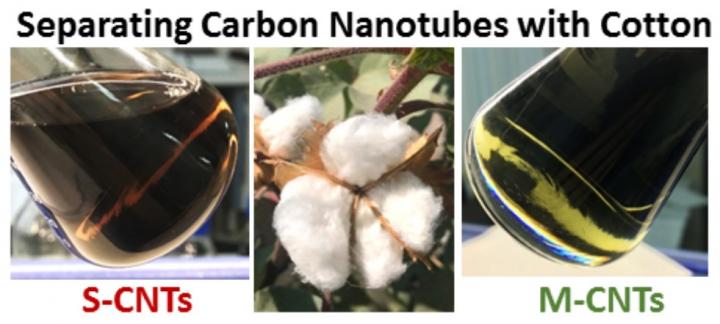A joint paper by Kazan Federal University and YTC America appeared in early access in Carbon.

Credit: Kazan Federal University
The project was kickstarted in 2017 when a delegation of YTC America (subsidiary of Yazaki Corporation) visited Kazan Federal University. During the talks, YTC suggested that KFU participate in developing effective methods of separating single-wall carbon nanotubes (SWCNTs) into metallic and semiconducting specimens. This was to be done on Tuball tubes produced by OCSiAl, since they are the only ones currently available in industrial quantities.
Carbon nanotubes (CNT) is a family of 1D nanostructures with numerous verified applications, made possible due to their excellent mechanical, optical and conductive properties.
However, application of CNTs is hampered by the presence of species with various structures in the raw production mixture, which obscures unique properties of individual species.
There are various methods for separating CNTs, but they can be hardly scaled up mainly because of the high cost of the used reagents. Notably, most of these methods were originally developed for sorting proteins, and were only recently adopted for separating CNTs.
In this paper, the authors propose a new, cost effective separation method, suitable for the industrial scale processing of CNTs. The method of separation is based on passing the CNTs surfactant solution through a column filled with chemically modified cotton wool.
One of the existing methods of separation, referred to as selective gel permeation, in its essence is a basic column chromatography. Namely, the CNTs surfactant solution is passed through a column, filled with beaded gels of agarose and/or dextran with the trade names “Sepharose” and “Sephacryl”. Both agarose and dextran are polysaccharides made from the glucose or glucose-like building units. Cellulose is a natural polysaccharide consisting of the same structural units. This is why the team decided to try this material as a column filler for selective permeation. Cotton is natural cellulose, possessing high surface area due to the fibrous structure. Co-author Timur Khamidullin, a PhD student in Ayrat Dimiev’s group (Laboratory of Advanced Carbon Nanomaterials, Kazan Federal University) made the first try with natural cotton wool purchased at a local pharmacy. Despite low sorting efficiency, there was some registered separation, i.e. cotton worked as a column filler. Inspired by the result, Ayrat Dimiev decided to chemically modify the cotton wool to change the chemical nature of its surface. Results were even higher that the expectations: this gave much better separating efficiency from the first very trial. It took another year and half of the collective group efforts to fine-tune both chemical modification of cotton, and the surfactants’ ratio in dispersing and eluting solutions.
The use of modified cotton wool allowed to achieve a level of separation which was never reported for Tuball CNTs before. In addition, modified cotton wool is about 200 times cheaper than the agarose- and dextran-based hydrogels, currently employed in the selective gel permeation separation method. The method’s scalability is limited only by the diameter of the separation column.
The main contribution to the work was made by group leader Ayrat Dimiev, PhD student Timur Khamidullin, and postdocs Shamil Galyaltdinov and Artur Khannanov.
In the raw production mixture, CNTs of different structures and properties obscure each other’s value. Industrial demand for separated CNTs will appear and grow in the coming years. CNTs with metallic type conductivity can be used in flexible transparent conductive films and even potentially replace metals in wiring. Semiconducting CNTs can be used as transistors and as platforms for imaging and targeted drug delivery due to their distinct and unique emission in the IR region. Thus, efficient methods for separating raw CNT production mixtures would raise application of CNTs on a new scientific and technological level. Moreover, the availability of ready-made separated nanotubes will spur the search for new directions of their application.
The main area of future work is to further increase the efficiency of separation by fine-tuning the separation process parameters and the structure of the modified cotton wool. The optimal structure of the modified cotton wool and the conditions for its production are still not fully understood; this question needs to be fully resolved. After this is achieved, the process should be scaled to industrial quantities, and separated nanotubes with various types of conductivity should be tested for practical solutions.
The paper has been made available online and is set to appear in print in June 2021.
###
Media Contact
Yury Nurmeev
[email protected]
Original Source
https:/
Related Journal Article
http://dx.




